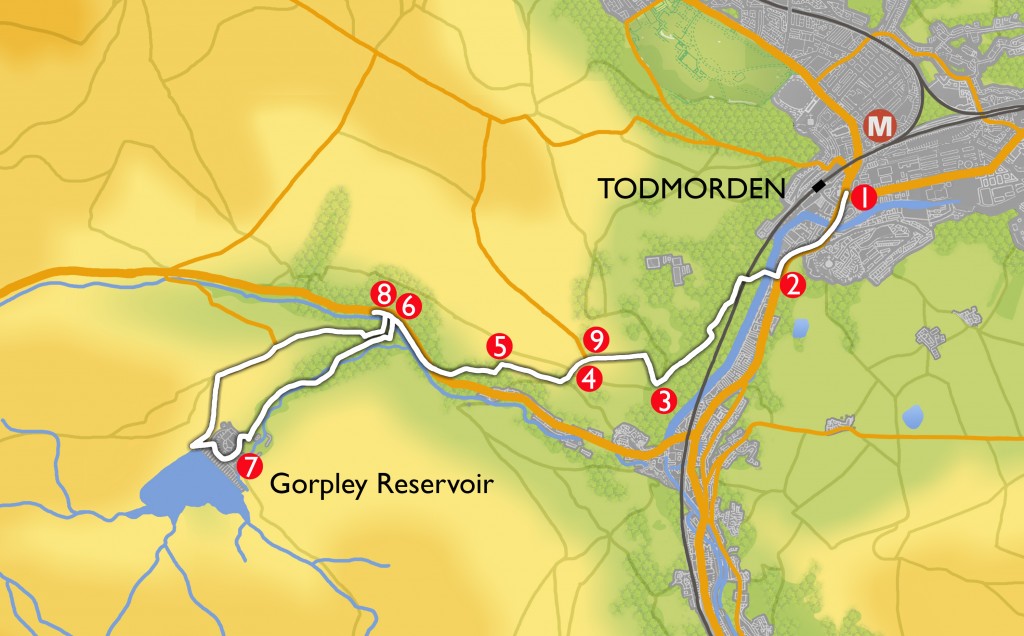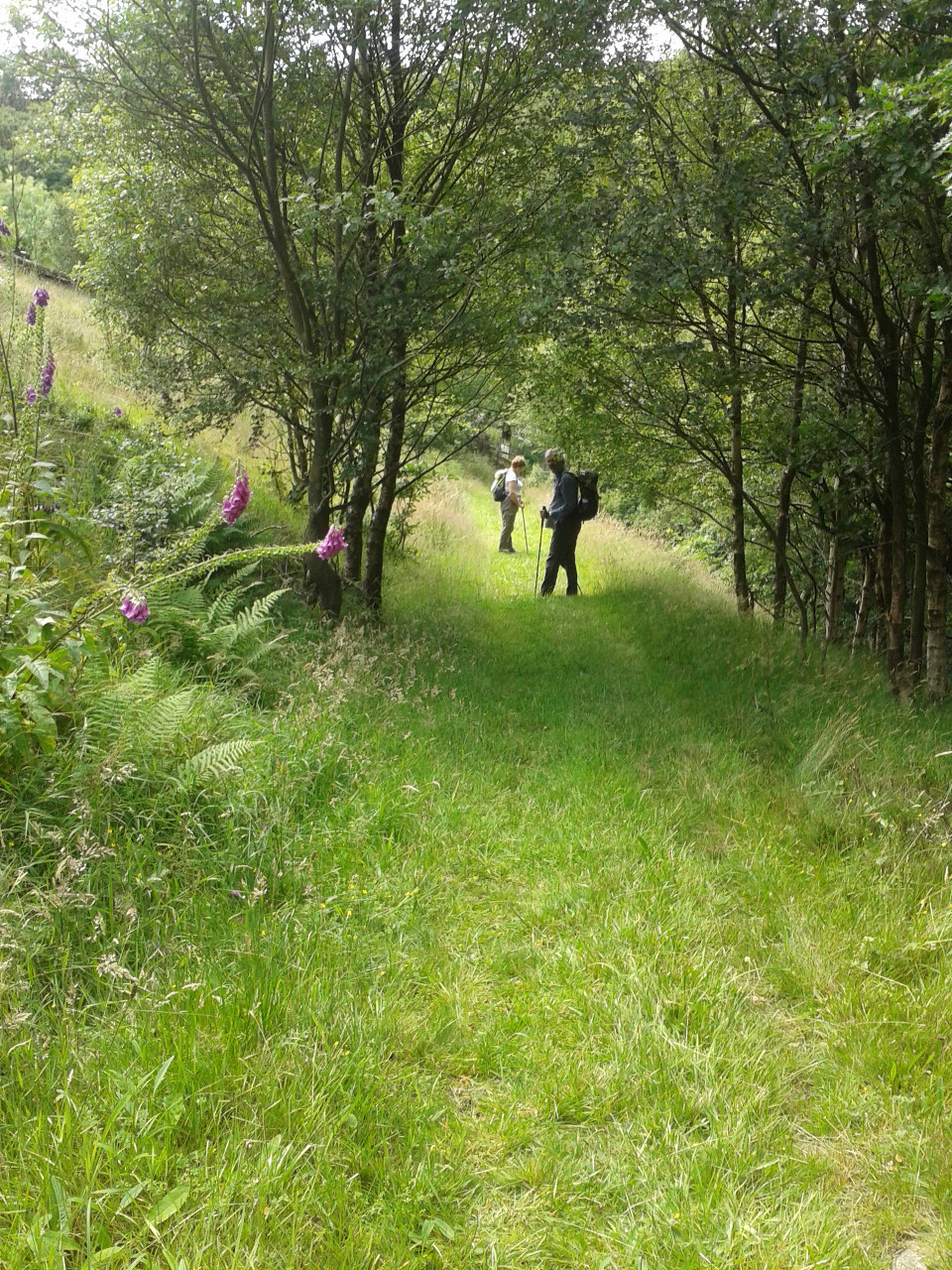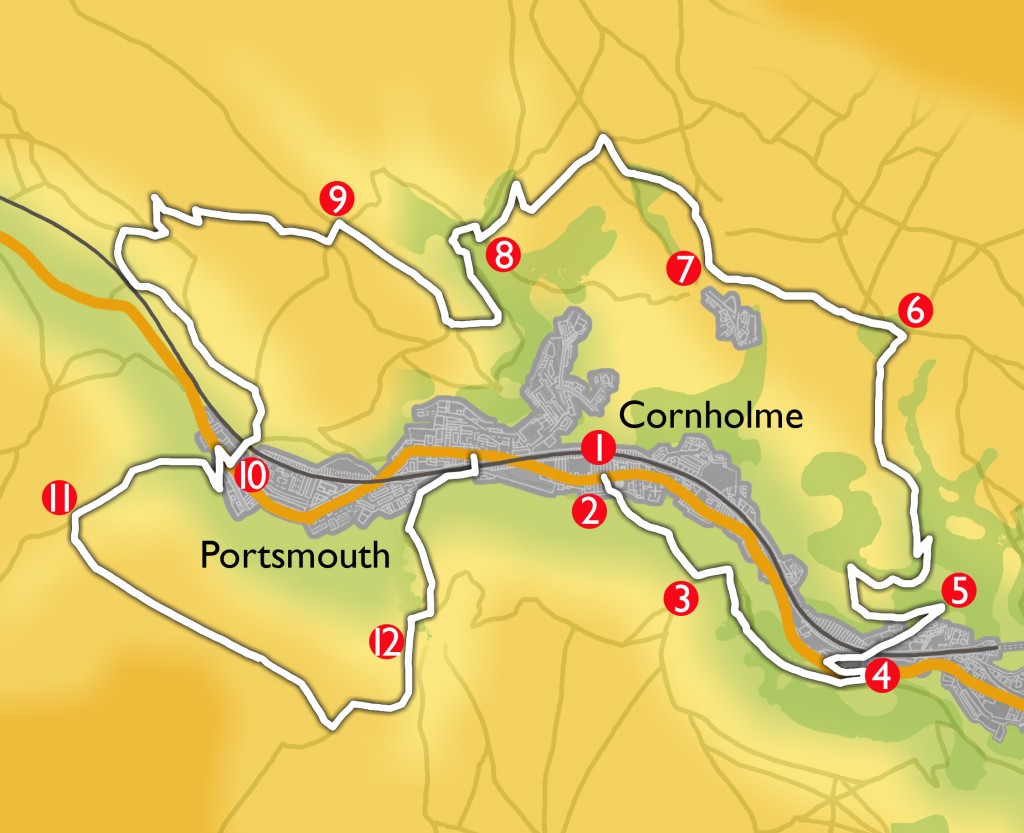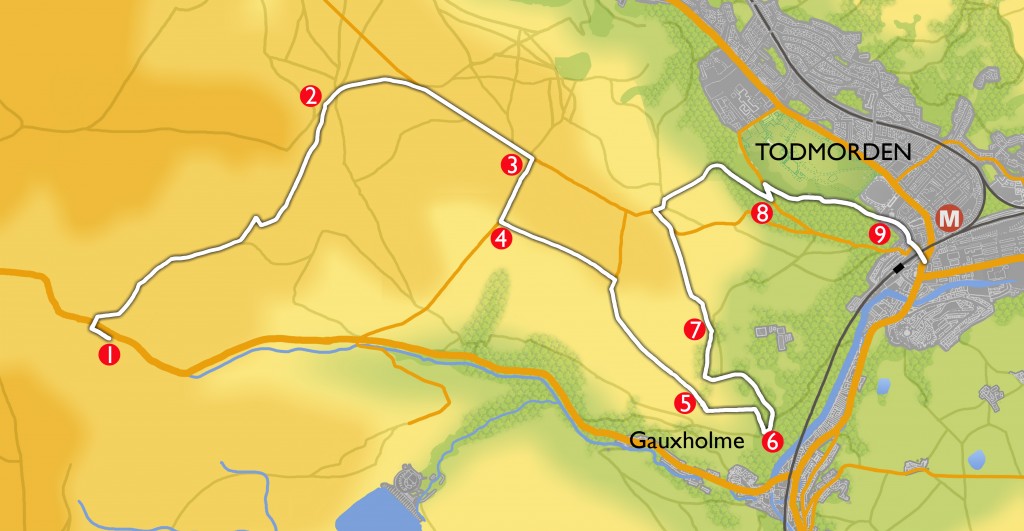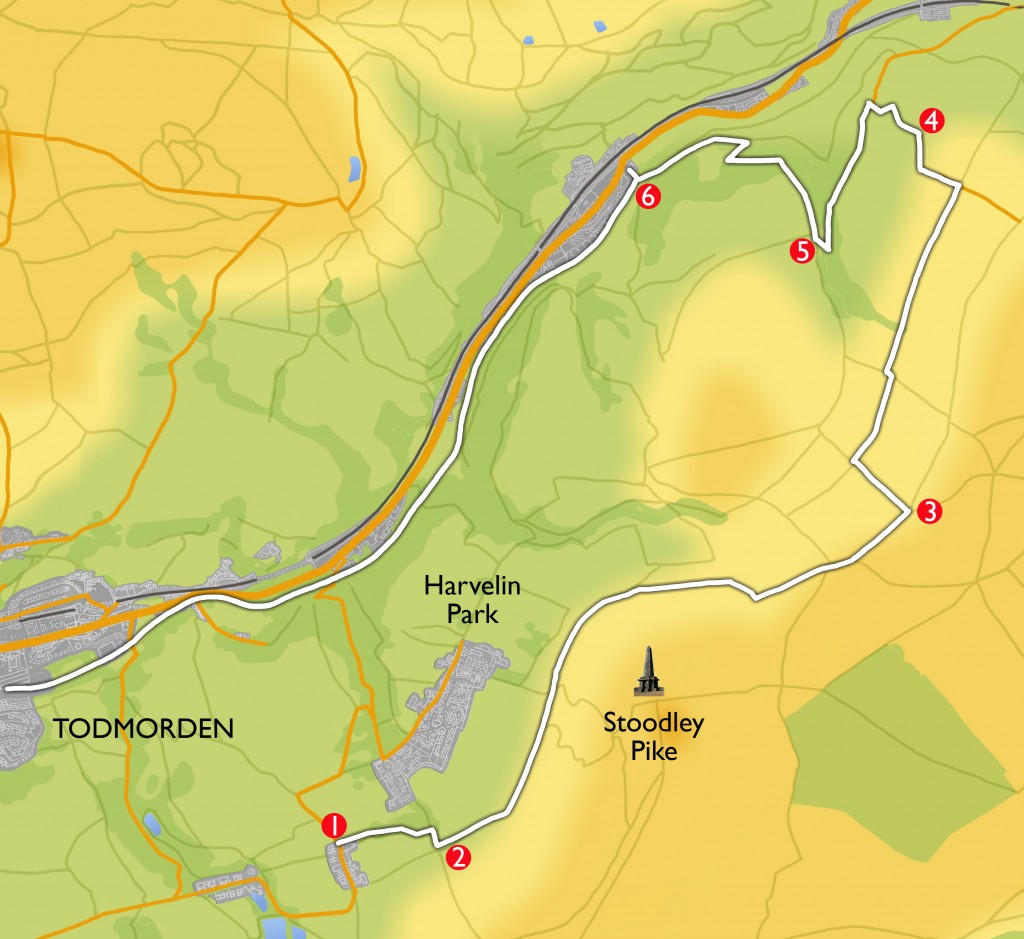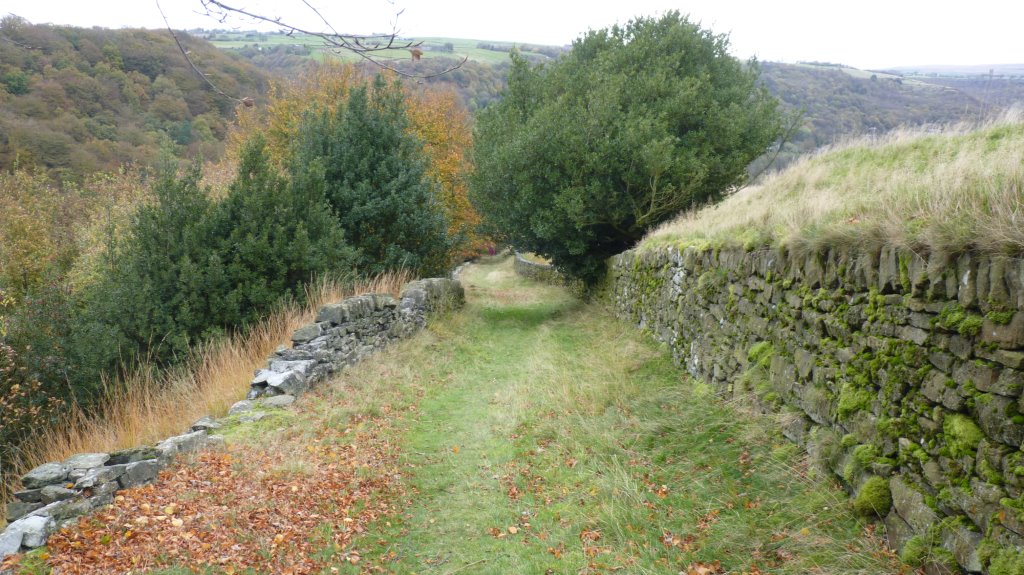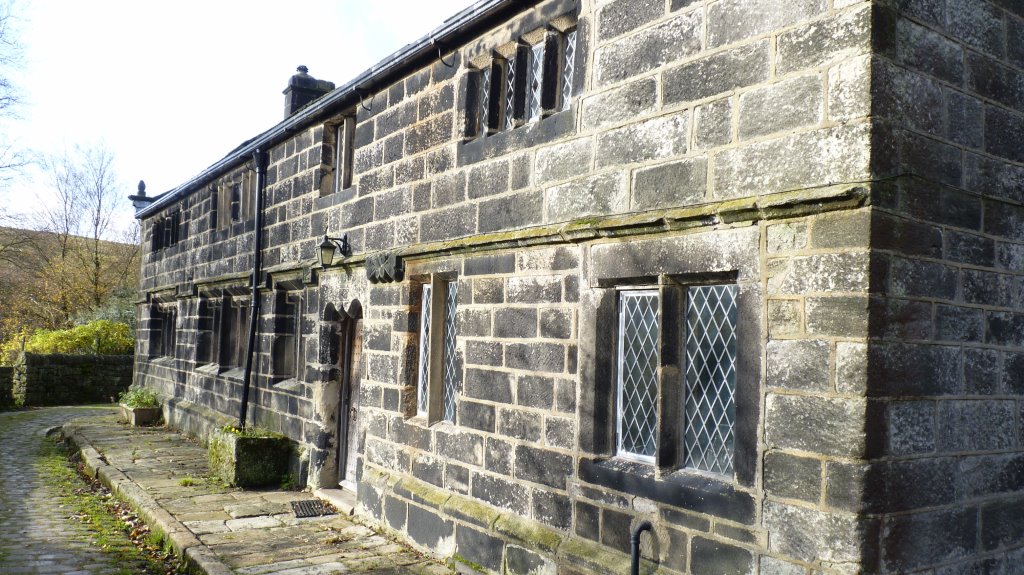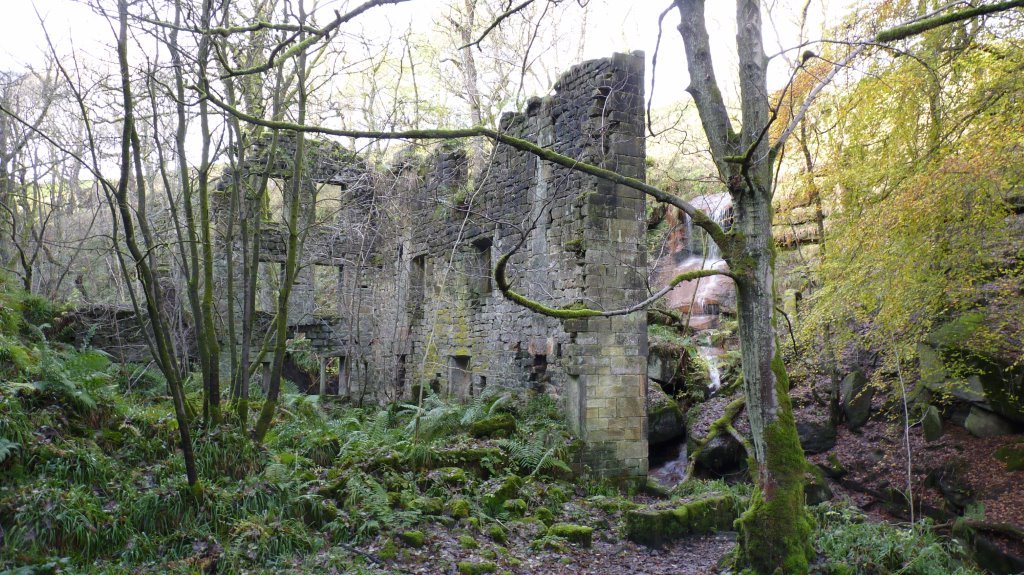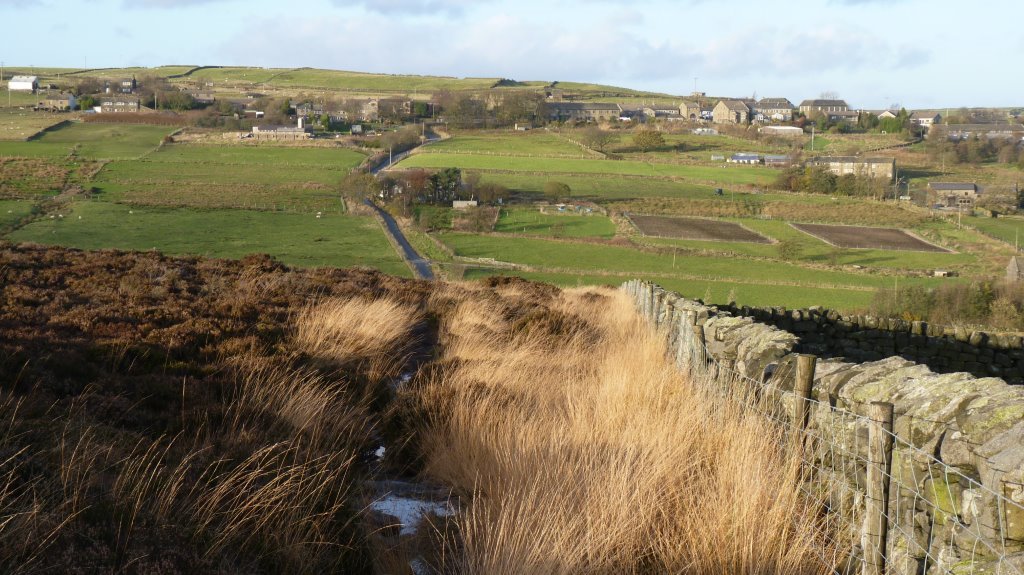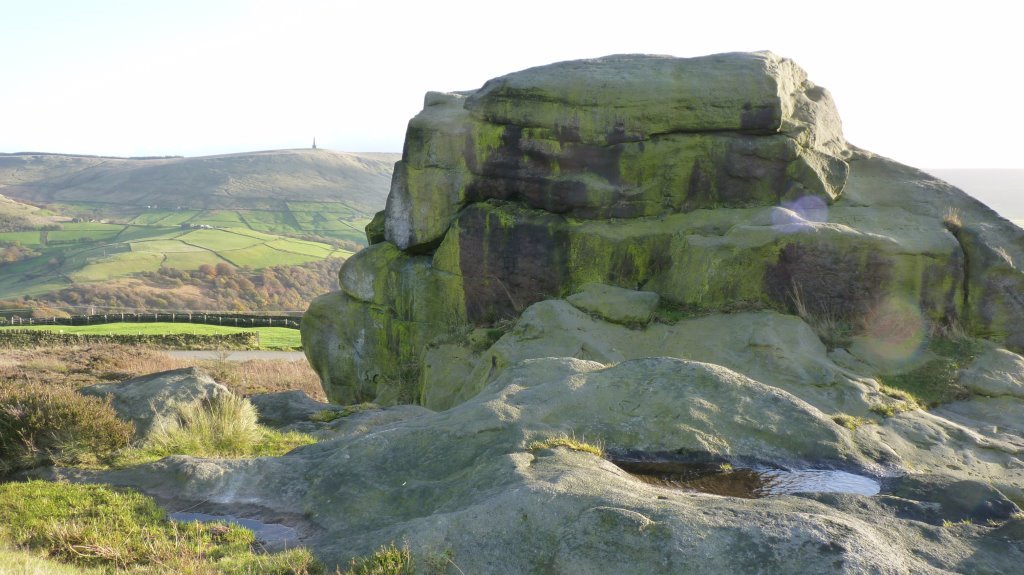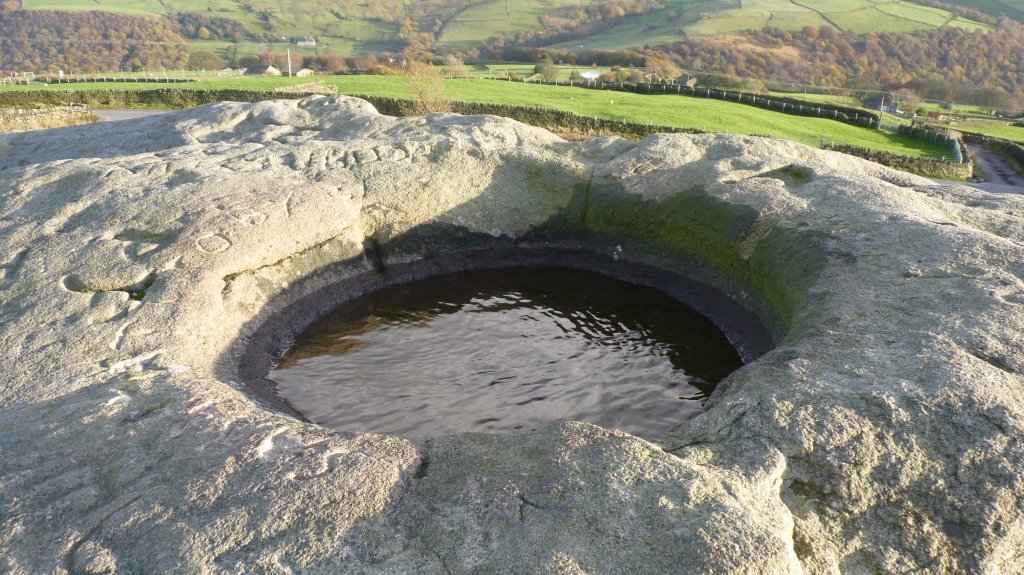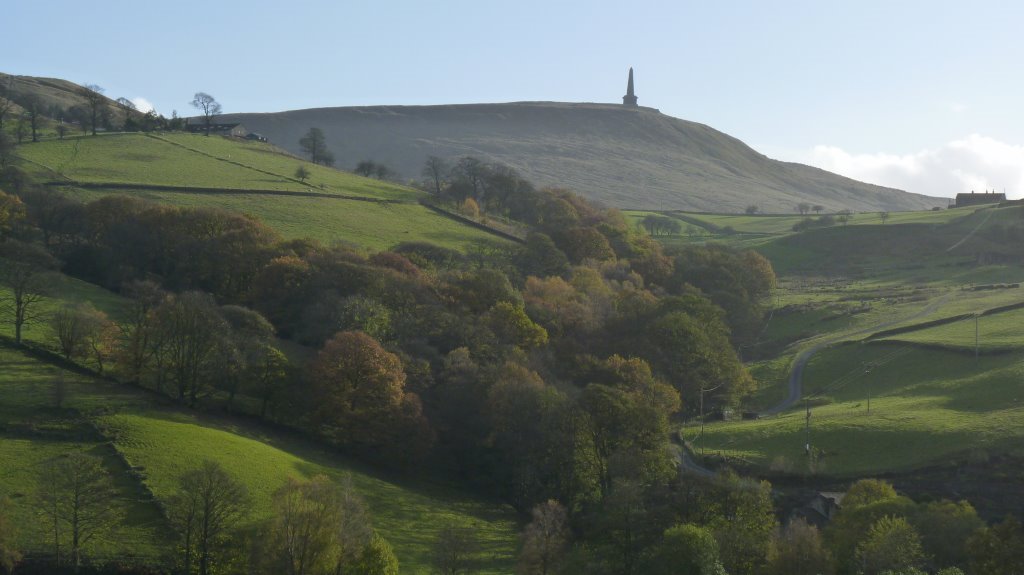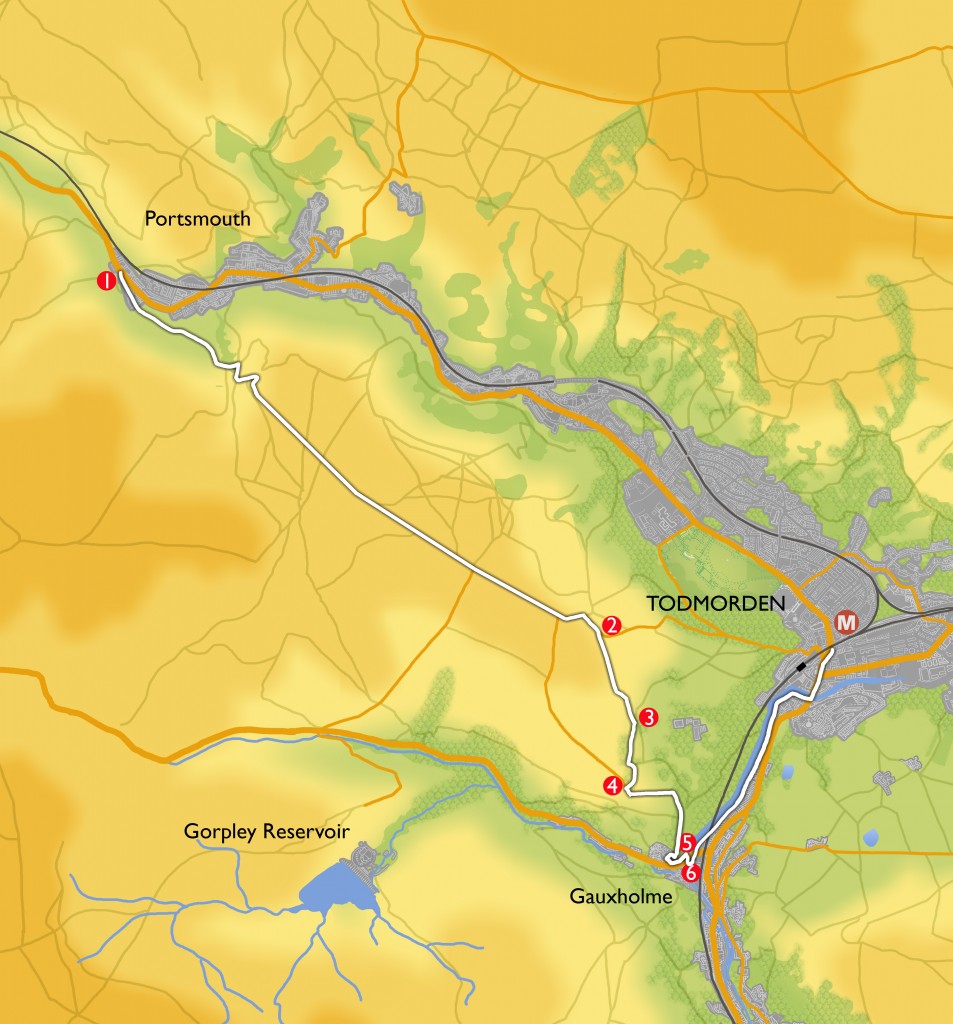Pictures (takes a little while to load)
Main features of the walk
This is a varied walk where the route is criss-crossing the upper Calderdale Valley with stunning views from across both sides. Highlights include the Great Rock, a lovely characterful 16th century house at Hippins,a close encounter with the atmospheric deserted Staups Mill hidden deep within the steep sided wooded valley of Jumble Hole Clough followed a lovely old ascending greenway track rewarded by a splendid balcony terrace traverse then hopping across a ford. The walk can be done in 2 parts with a break where it reaches the Rochdale Canal at Burnt Acre
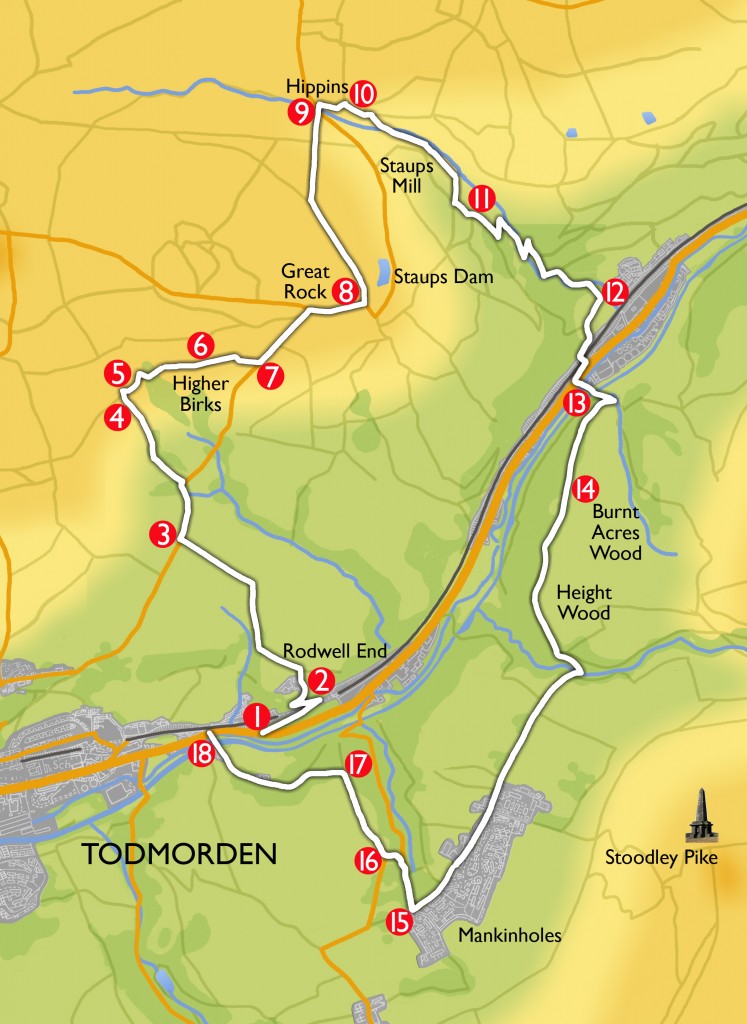 Length of walk and time it will take you
Length of walk and time it will take you
It is about 11 km (7 miles) and should take up to 4 hours plus.
Gradients
It is a challenging walk, going up then down the steep valley sides twice.
Terrain
There are some steep valley side paths to negotiate; with some steep drops in place.
Obstacles
There are many stiles and gates along the route, some steep and sometimes slippery steps, and a couple of scrambly sections
Facilities on the walk
A Picnic Area with benches at the start and end but none on the route
What to wear/take.
You will definitely need walking boots and take plenty of food and drink.
Description
Take the 590 or 592 Halifax bus from Todmorden Bus Station. Ask for the Horsfall Street stop. Walk along the main road (Halifax Road) in the same direction to arrive at the Lobb Mill Picnic Area and car park.
-
Leave the car park by the waymarked path at the far end, rising steadily across an attractive open heathland area with heather and silver birch trees. Follow the path as it steeply climbs zig-zagging sharp left then at a sharp right hairpin look down on the railway tunnel entrance below. Continue up to quickly gain height. Avoiding any lesser paths stick to the main track, at a waymark take the left path upwards.
-
Near the top the path becomes enclosed by stone walls as you enter the small hidden hamlet of Rodwell End with lovely old stone houses. Pass straight through bearing slightly right to take a rough access track out. At a T- junction turn left. The track bears right with twin rough tarmac tracks and continues to rise between stone walls. Ignore any footpaths off this track, and after some distance it reaches a road (Cross Stone Road.)
-
Turn right along the road for nearly 300m and then turn left between two houses up Butts Road. Climb steeply for 500m passing a small cluster of houses until the road turns sharply left and becomes unsurfaced by a lone house.
-
Here take a short enclosed way right upwards signposted Calderdale Way Link Path for 50m passing though a small gate to reach a crossroad of paths.
-
Turn right to pass through a gap in a tumbled down stone wall in 10m then follow the path reaching a small tree lined stream. There are some tumbling waterfalls upstream when the stream is flowing well. After crossing the stream in 15m do not follow the path ahead, but instead go left briefly uphill then right before resuming a level course ahead passing above the house (Higher Birks) on your right, then proceeding ahead along the bottom of the field .
-
On the far side fork left up an old sunken way which rises gently for 150m between tumbled down old walls, then doubles back left then right before it levels out. At around 320 metres/1050 feet you are almost at the highest point on the walk but you have done the hardest ascent now. Continue along this pleasant greenway at the bottom of the field with a wall on your right passing through what may be a very muddy gate/stile, The path becomes enclosed where it meets a tarmac road.
-
Turn left up to a T-junction, (the highest point of the walk) then right passing a lone house on the left to reach the prominent outlier known as Great Rock. The road loops around it. You can get to the top by scrambling up the far side. There are superb views across upper Calderdale, with the eye inevitably drawn to Stoodley Pike on the other side of the valley. A great place to take a breather after your climb and to savour the fine panorama.
-
Leave Great Rock by the track on the left going up behind the rock (with the road behind you). Keep an eye out for llamas which can sometimes be seen in the fields on the right. This might not be as high as the Andes, but these animals seem to be at home in this exposed spot! Pass though a gate, then cross a stile . You enter the open upland country of heathery Staups Moor where you may see and hear grouse ,skylarks, meadow pipits and curlews. The path descends for 400m with a wall on your right. Cross a track and clamber over the ladder stile, continue to drop down over sedge filled pasture to a waymark post on the brow. Descend steeply down some steps where care is needed to a stile next to the road.
-
Cross over (Hippins) Bridge then turn immediately right on a short access track signposted Calderdale Way to Hippins.
Hippins is a Grade II listed Yeomans House with vernacular architecture typical of this area initialled and dated 1650 above the ogee lintel and chamfered surround of a splendid old wooden front door. It is constructed of large dressed local stone with a stone slate roof and chamfered mullioned windows. A characterful gem of a 17th century house with an attractive cobbled front access.
Just after passing the house go right through a gate and follow the path with a stone wall on your left.
-
By a four way signpost branch off to the right, and descend a path towards Jumble Hole Clough. This brings you to a small metal footbridge which you take over the stream.Turn left and after 110m start the descent of Jumble Hole Clough down some scrambly steps. (Clough is the local name for a steep sided wooded valley which is typically found in this part of the South Pennines). Look out for the waterslide immediately downstream and the line of the water channel constructed to supply Staups Mill which the descending path by the tumbling stream leads you to.
Staups Mill is now a picturesque ruin at the top of Jumble Hole Clough. It is a derelict late 18th century cotton mill hidden deep within the steep confines of the clough that oozes atmosphere, a magical spot, brilliant for a picnic stop or photo opportunity, always a delight to visit. At its height in 1811 it was recorded as having 2 spinning mules with 216 spindles each. On September 24th 1896 7 metres of the retaining wall of the upper dam collapsed and water rushed down Jumble Hole causing great damage but fortunately there were no casualties. Its attractive but remote location with access only on foot or by packhorse led to its ultimate demise as it could not compete economically with larger mills with good transport links. Get your passport ready, as the river here forms the boundary between Todmorden that you have been in, and Hebden Bridge that is on the opposite bank.
-
Leaving the mill the path rises briefly, but look out in 50m for the yellow waymark taking you on a less obvious path off to the left. You proceed parallel to, but high above the beck with occasional glimpses of the fast flowing tumbling stream way down on the left. There are a couple of rocky crags that you need to take care to scramble over. The path descends steadily, to cross angled paths and then briefly levels off as you follow the bottom edge of two fields. Returning to thicker woodland initially you descend on a rugged path before reaching the corner of a concrete farm drive. Continue to descend passing an old mill pond on the left with various old industrial workings in the vicinity ahead. 120m further on follow the sharp hairpin bend left for a further 60m then turn right to cross the bridge over the stream. From the bridge parapet just upstream is an impressive crescent weir 4m in height with a curtain of water falling over the drop. You now follow the concrete track downhill with the stream on your right, and coinciding for a short while with the Pennine Bridleway National Trail.
-
Near the bottom of the woodland just before the first houses turn right to cross a footbridge then take a less used footpath that goes into a field and follows the righthand wall up a small knoll. Here there is a welcome stone seat with a dedication “IN LOVING MEMORY OF KATH”. There are lovely views of the steep valley sides and dense woodland that are characteristic of the Calder valley, with Stoodley Pike on the skyline.
Continue along the path with the wall on your right passing the back of Mulcture Hall, though a tight stile and the garden to emerge on an access road. Turn left past the side of the house. At the next hairpin bend leave the track and continue straight on along a waymarked grassy footpath that runs between trees and the railway. Turn left to cross a tall metal sided footbridge over the railway line, to drop down to the main road running along the valley floor If you want to finish the walk here then you can walk some 300m along the pavement right to then cross the road to a bus stop. The 590 or 592 bus will take you back to the Todmorden Bus Station. Alternatively if you want an easier walking route back into Todmorden you can cross the main road onto Burnt Acres Lane then go right just before the bridge to join the Rochdale Canal Towpath that offers a level well surfaced path of 3.5 km back to the town centre.
-
To continue the walk carefully cross over the main road onto Burnt Acres Lane. Cross the River Calder and the Rochdale Canal.Continue beyond the canal bridge then start heading left up the tarmac road past a multi- terraced garden that is on your right. Ignore a first path off to the right by a red notice “ Private No Parking” , instead take a 2nd path 100m around the corner on the right which doubles sharply back along the top side of the terraced garden. Go through a small wooden flap gate then gently but steadily climb up a well engineered greenway that goes along the escarpment slope on the top side of Burnt Acres Wood.
-
As the track turns to the left, instead continue straight ahead passing between 2 standing stones, former gateposts, on a waymarked footpath, with a stone wall on your left. Ignore a crossing footpath at 60m proceeding along a terraced footpath that grips the scarp edge and goes though the woodland edge until you cross over a stile at 120m, coming to a more open promontory. The hillside here can be covered in waist high bracken in the summer and autumn. From here there are views below looking down along the Calder valley, and across the other side you will be able to spot the Great Rock opposite. This splendid viewpoint is appropriately named Height Wood. Continue on the path ahead for 480m with a stonewall on your left. Gradually bear round to the left , to come out onto the corner of a farm access track. Head down the track for 90m, then where the track bends right you depart by taking the footpath left down to a small ford. It is easy to hop across the stream here on a few convenient stones, provided it is not in full spate. Go through the wooden flap stile then ascend steeply passing a house on your left, to reach the brow of the access road. Continue straight on to where the track merges into a tarmac road. You are now on Lee Bottom Road, you pass the gate post entrance to Stoodley Grange on the left which was originally a Victorian Children’s Isolation Hospital converted in 1994 to private dwellings. Walk along Lee Bottom Road for 500m passing Harvelin Park and Manor Close road exits on the left.
-
Reach a right hand bend to join Upper Shaw Wood Road (also known as Broad Gate on some maps), look out for spring bubbling into an attractive stone trough. Continue along to reach a junction, turn left into New Road up around the left bend , then look out for entrance driveway to Shaw Farm Livery with metal gates on the right. Just before these gates on the right cross over a stile in the stone wall.
-
Proceed along a footpath skirting the riding centre on your left hand side, initially along a stone flagged path passing a small ornamental pond on your right through a wooden bridleway gate with a notice “ Horses Enter at Own Risk” .With a stone wall on your left and a wooden post and rail fence on your right continue along a stone flagged route, possibly muddy. Pass through a bridleway gate part way along then proceed through another wooden bridleway gate with a metal fieldgate on your right at the end of the field. Continue across the field for 35m to cross the stile ahead through a stone wall.
-
You now traverse left heading down along the edge of Shaw Wood along a steep sloping wooded path through a gap stile in a fence, skirting along the bottom edge of the wood with views across to the right down to the Rochdale Canal and railway viaduct at the bottom of the valley. Carry on along this descending footpath to come out besides 2 isolated houses on the right, then join their access track which merges into the tarmac (Haugh Road) towards the valley bottom . Cross over the Rochdale canal ahead and the river Calder to come out on the main Todmorden to Halifax road (the A646).
-
Proceed right along the footpath, where you will reach a bus stop for the 590 or 592 bus back to Todmorden Bus Station. Alternatively continue for a final 100 metres then carefully cross the road to return to the Picnic Area from which you started.


